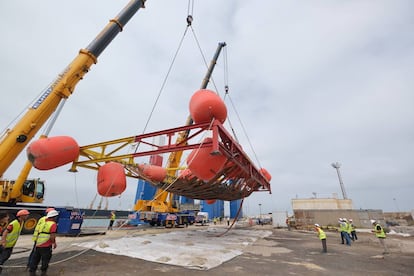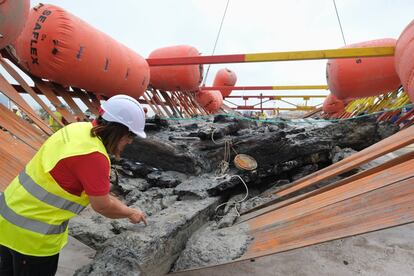He Delta Ithe mid-17th century ship that sank almost 400 years ago for an unknown reason, has emerged this morning from the depths of the port of Cadiz. The manoeuvre, a pioneer in Spain, took more than four hours to complete successfully, confirmed the Port Authority of the Bay of Cadiz (APBC) and the Delegation of the Junta de Andalucía in Cadiz, the architects of the operation. The historic wreck, 20 metres long by seven metres wide – corresponding to the preserved lower part of the vessel – will now be moved to a tent, where it will be dismantled, scanned and studied, before being returned to the sea.
This Saturday’s movement – reported through a press release and without a call to the media – is the fifth phase of the six that the operation of studying the Delta Inamed as such by the team from the Centre for Underwater Archaeology (CAS) in Cadiz when it was found in 2012, during the course of works to expand the port. Back then, the CAS specialists had to commission the company Navantia to build a metal structure that they submerged under water and tied to the wreck in order to move it from the bed where it was buried in mud, at a depth of about 19 metres, to an underwater area of between six and eight metres (depending on the tides) where it had been since then.
The need for new works in the area surrounding the new container terminal, which required its movement more than a decade ago, has now justified the raising of a ship whose name, flag and the circumstances that led to its sinking are unknown. Although to get to the point where the remains of the wreck emerge, something that happened at midday, it took weeks of work under the sea that began last spring. Divers from the Divership Diving company had to remove “by touch”, as explained by the APBC, between one and two metres of mud, which settled on the wreck after its last movement 12 years ago, and dredge the area to locate the straps that embrace the structures placed then.
The technicians from the port of Cadiz (which is also financing the operation, with an investment of 2.6 million euros) have been in charge of designing the transfer manoeuvre, calculated on the weight of the wreck, resulting from the inventory carried out in 2012 of the wood that makes up the ship, saturated with water. For the lifting, they have used again the iron structure that was used then and that was launched again into the sea 17 days ago, equipped with floats that made it remain under water. Once towed to the area where the wreck was, the specialists emptied these inflatables so that this frame would lower itself to the ship and be supported on concrete blocks, placed almost blindly beforehand by the divers so that they coincided exactly with the legs of the structure.
Once the ship was fastened to the structure with the help of straps, tensioners and shackles, the technicians inflated the floats again to lift the whole assembly, which was towed to a dock in the port, where it was moored last Friday. There, the divers carried out a new superficial cleaning of the mud that the wreck had, until this Saturday the hoisting was completed with the help of two mobile cranes located next to the cliff. The remains of the ship ended up resting on some sandbags on a sandy esplanade and were detached from the metal structure.
Phase 6 of the operation will involve technicians from the CAS and the Andalusian Institute of Historical Heritage (IAPH), the institution to which it depends. Under a 25-metre tent that will be installed to protect the place where the wreck has been located, archaeologists will work in controlled conditions of humidity and temperature to study it. The idea is that, over the next three months, the specialists will document and dismantle the wreck to find out what the structure of the ship was like. These analyses will be key to discovering what happened to the ship and how it was built, in the mid-17th century, a time when there were no guidelines for how ships were made, Milagros Alzaga, head of the CAS and main architect of the project, explained to EL PAÍS.

The plan to follow will be to dismantle the ship’s internal lining and continue with the frames and the exterior covering. The archaeologists will take a sample of wood from each area to carry out dendrochronological studies that will allow determining the age and origin. This will be completed with various photographic and photogrammetric documentation. Afterwards, the pieces will be placed in containers of salt water to end up back in the sea, protected with geotextile (a permeable and flexible fabric) and mud. The complexity of stabilizing the wood out of the water, maintaining it and putting it into a museum has led to ruling out for now that the wreck will end up exposed out of the sea.
For now, everything is unknown in the Delta I. It is only known that, at the time of its sinking, it was loaded with 27 iron cannons from Sweden; 22 silver ingots, originating from the mines of Upper Peru (today Bolivia) with marks dating them to 1651; ceramics and a bell with the legend Jesus, Mary and Joseph. All these pieces were recovered in an archaeological campaign carried out under the sea in 2013 and needed months to years to be stabilised out of the sea. Now, the CAS technicians face this work as an opportunity to resolve the doubts surrounding the ship that emerged from the depths of the Atlantic almost 400 years after it was swallowed by the Atlantic.

